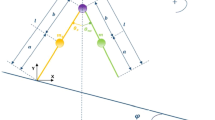Abstract
It is well-known that a suitably designed unpowered mechanical bipedrobot can “walk” down an inclined plane with a steady periodicgait. The energy required to maintain the motion comes from theconversion of the biped's gravitational potential energy as itdescends. Investigation of such passive natural motions maypotentially lead us to strategies useful for controlling activewalking machines as well as to understand human locomotion.
In this paper we demonstrate the existence and the stability ofsymmetric and asymmetric passive gaits using a simple nonlinear bipedmodel. Kinematically the robot is identical to a double pendulum(similar to the Acrobot and the Pendubot) and is able to walk withthe so-called compass gait. Using the passivebehavior as a reference we also investigate the performance ofseveral active control schemes. Active control can enlarge the basinof attraction of passive limit cycles and can create new gaits.
Similar content being viewed by others
Explore related subjects
Discover the latest articles and news from researchers in related subjects, suggested using machine learning.References
Bavarian, B., Wyman, B.F., and Hemami, H. 1983. Control of the constrained planar simple inverted pendulum. In International Journal of Control, 37(4):741–753.
Berkemeier, M.D. and Fearing, R.S. 1992. Control of a two-link robot to achieve sliding and hopping gaits. In Proc. of IEEE Conf. on Robotics and Automation, Nice, Vol. 1, pp. 286–291.
Block, D.J. and Spong, M.W. 1995. Mechanical design & control of the pendubot. In Proc. of SAE Earthmoving Industry Conference, Peoria, IL.
Dunn, E. and Howe, R.D. 1996. Foot placement and velocity control in smooth bipedal walking. In IEEE International Conference on Robotics and Automation, Minneapolis, MN, U.S.A.
Espiau, B. and Goswami, A. 1993. Compass gait revisited. In Proc. of the Symposium of Robot Control (SyRoCo), Capri, Italy.
Gajewski, K. and Radziszewski, B. 1987. On the stability of impact system. Bulletin of the Polish Academy of Sciences, 35(3/4):183–189.
Garcia, M., Chatterjee, A., Coleman, M., and Ruina, A. 1997. The simplest walking model: Stability, complexity, and scaling. ASME Journal of Biomechanical Engineering (accepted).
Golliday, C.L. and Hemami, H. 1977. An approach to analyzing biped locomotion dynamics and designing robot locomotion controls. IEEE Trans. on Aut. Cont. AC, 22(6):964–972.
Goswami, A., Thuilot, B., and Espiau, B. 1996. Compass-like biped robot Part I: Stability and bifurcation of passive gaits. Technical report, INRIA. No. 2996.
Grishin, A.A., Formal'sky, A.M., Lensky, A.V., and Zhitomirsky, S.V. 1994. Dynamic walking of a vehicle with two telescopic legs controlled by two drives. International Journal of Robotics Research, 13(2):137–147.
Hayashi, C. 1985. Nonlinear Oscillations in Physical Systems. Princeton University Press: Princeton, NJ
Hurmuzlu, Y. and Moskowitz, G.D. 1986. The role of impact in the stability of bipedal locomotion. Dynamics and Stability of Systems, 1(3):217–234.
Hurmuzlu, Y. and Chang, T.-H. 1992. Rigid body collisions of a special class of planar kinematic chains. IEEE Transactions on Systems, Man, and Cybernetics, 22(5):964–971.
Kelso, J.A.S., Holt, K.G., Rubin, P., and Kugler, P.N. 1981. Patterns of human interlimb coordination emerge from the properties of non-linear, limit cycle oscillatory processes: Theory and data. Journal of Motor Behavior, 13(4):226–261.
McGeer, T. 1990. Passive dynamic walking. Int. J. of Rob. Res., 9(2):62–82.
Miura, H. and Shimoyama, I. 1984. Dynamic walk of a biped. Int. J. of Rob. Res., 3(2):60–74.
Ott, E. 1993. Chaos in Dynamical Systems. Cambridge University Press: UK.
Author information
Authors and Affiliations
Rights and permissions
About this article
Cite this article
Goswami, A., Espiau, B. & Keramane, A. Limit Cycles in a Passive Compass Gait Biped and Passivity-Mimicking Control Laws. Autonomous Robots 4, 273–286 (1997). https://doi.org/10.1023/A:1008844026298
Issue Date:
DOI: https://doi.org/10.1023/A:1008844026298




